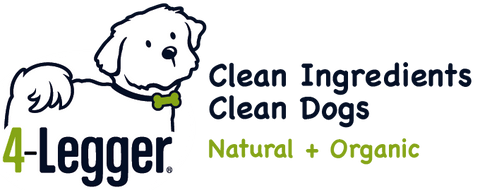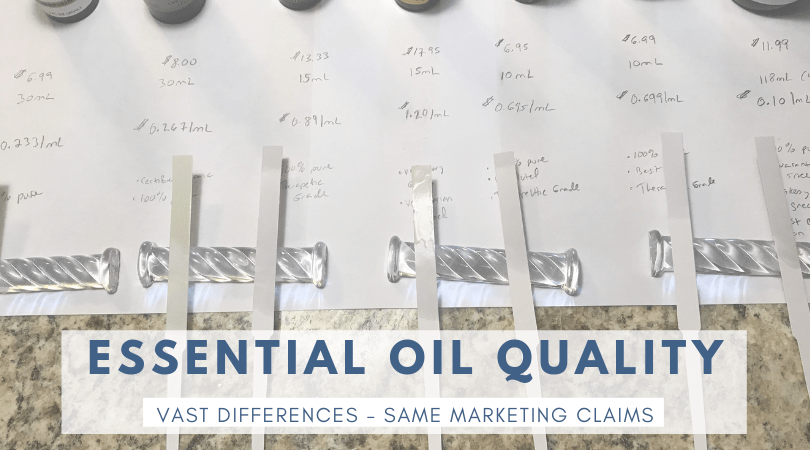The Safe Use of Essential Oils for Dogs, Cats and other Animals
Months ago some friends, including a dog neurologist who uses essential oils with her patients came over to the house to participate in an experiment!
The experiment was to smell a multitude of brands of essential oils to determine if they could identify quality, called the art of organoleptics (to identify with the senses).
Everyone sat around the table and one by one a fragrance test strip with an unknown brand of lemongrass essential oil on it was brought in from an adjacent room and passed around the table for everyone to smell. Everyone first sniffed with their right nostril. Then left. Then both. After sniffing, each person recorded their reaction to that brand's essential oil without seeing the bottle or knowing anything about it.
The reactions to the oils were exactly what we had expected.
Some essential oils made a nose or eye runny or caused head pain. Others made the head pain and runny nose go away. Some thought the lemongrass didn't smell anything like lemongrass and assumed those were lower quality essential oils.
When we got done, we brought all of the essential oils into the room in their bottles and put them on the table along with a GIANT sheet of paper that had the name, cost, and cost per ounce, the test strips, our copy of Robert Tisserand and Rodney Young's book Essential Oil Safety, and if we could find it, the gas chromatography/mass spectrometry (GC/MS) data.
When everyone had left I put all the smell test strips on pieces of paper and spread them around the room to see how the dogs would interact with them.
Again, the results were exactly as expected. The dogs willingly went to some of the samples but clearly avoided others. The synthetic and/or poor quality samples were obvious even to the pups!
Here are some of the lessons learned:
- When side by side, each participant correctly identified the higher quality oils. The dogs completely avoided the low quality and synthetic oils when they were placed on the floor.
- The consensus was that if the essential oils were not side-by-side it would be difficult to discern the subtle differences between the brands or see a direct correlation between the essential oil and the watery eyes, runny hose, or head pain.
- In all but 1 case (a low cost synthetic fragrance oil), the lowest quality oils caused a negative reaction (or was completely avoided by the dogs).
- Synthetic fragrance oils (I refuse to call them essential oils) are cheap inferior products that may cause long term health issues. They also often smell more like what you think they should smell like because our brains are trained to recognize synthetic scents over natural ones since the market produces far more synthetic oils for use over natural oils.
- There are no marketing standards for essential oils. An essential oil that cost $0.10/ounce had the same exact terminology on the bottle (100% Pure. All Natural. Therapeutic Grade) as an essential oil that was nearly $1.00/ounce. The most expensive oil at $1.20 / ounce had "veterinary grade" on the bottle because a holistic veterinarian had screened and selected that essential oil.
It can be difficult to identify essential oil qualities and it can be even more difficult to identify a synthetic from a truly all natural essential oil. With a LOT of practice you can train your nose to identify the differences.
There is real danger in using low quality or synthetic oils.
The Difference Between Essential Oils and Fragrance Oils
Pure essential oils (called NEAT oils) are extracted from different parts of plants such as the flower via steam distillation or cold pressing. They are 100% pure oils not having been processed, diluted or manipulated with solvents or other additives. There are CO2 and solvent extraction methods which you need to be aware of as well.
The climate, amount of rainfall, temperature, soil condition and other factors determine the chemical composition and quality of the oil. With each harvest of a crop (such as lavender), the quality and scent of that oil is affected by the environment as well as the steam distillation process, so they will vary from year to year.
Fragrance oils (sometimes called synthetic essential oils) are manufactured in the laboratory. Since each oil contains a complex combination of chemicals, it is no surprise that they also may contain a number of toxins such as benzaldehyde, benzyl acetate, propylene glycol, parabens, and sulfates just to mention a few.
It is estimated that 95% of the chemicals in fragrance oils are derived from petroleum byproducts. Also added to synthetic fragrance oils are chemicals that make them "sticky" so the smell will linger and cling to clothing, hair, furniture, etc. It allows the scent of the smell to persist for hours or days but you are exposing yourself to a host of unhealthy chemicals.
Harmful Chemicals, Your Dog's Skin and Long Term Health Implications
It is estimated that over 60% of what you put on your dog's skin (the largest organ of the body) gets absorbed into their bloodstream. The skin is your dog's barrier against environmental assault. This is true for humans too.
That fabric softener that makes clothes and blankets retain smell for days or weeks after washing is from fragrance oils. Likewise, that dog shampoo you washed them with may smell great, but it may also be the root cause of endocrine disease, thyroid disease, and other health issues if they contain artificial, synthetic, or low quality ingredients.
Price Differences
When asked why our organic dog shampoo costs more than another dog shampoo that uses essential oils consider the conclusions of the experiment.
Lower cost essential oils are put into lower cost products. If you want the higher quality oils that have known safety margins, they simply cost more.
We strongly believe that cost is worth every penny especially when considering it’s the health and life of an animal at risk.
You get what you pay for.
Health Benefits
If you are going to use an essential oil on or near your fur family you need to be very cautious about the quality of the oil as it can have an impact on their health.
Dr. Melissa Shelton DVM used essential oils in her holistic veterinary practice and discovered low quality essential oils and synthetic fragrances actually has an impact on bloodwork results - white blood cells, liver enzymes, etc.
Pure essential oils have something the fragrance oils don't - the natural power of healing. For example, lemongrass essential oil is a natural deodorizer that supports the skin, reduces yeast and bacteria, and helps to deter bugs it also also been shown to reduce anxiety and improve cognitive function (and more).
At the conclusion of the experiment, the veterinarian at the table commented how valuable it was to interact with the oils first hand and experience the differences. She made a note that when discussing how to best support animals with essential oils she needed to also discuss the quality of the oils with her patients.
Using a truly safe and non-toxic dog shampoo like 4-Legger's organic dog shampoo you don't have to worry about contaminants or ingredients not being listed. They are all on the bottle as verified by the National Organic Program!
Give your dog a healthy bath. Check out our selection of safe and non-toxic dog shampoos and animalEO essential oil blends.





